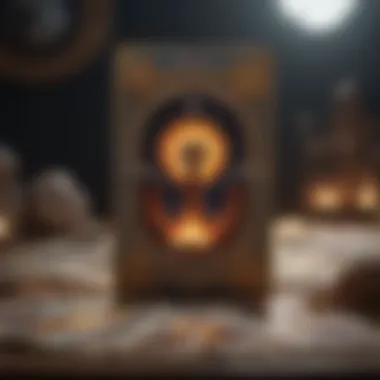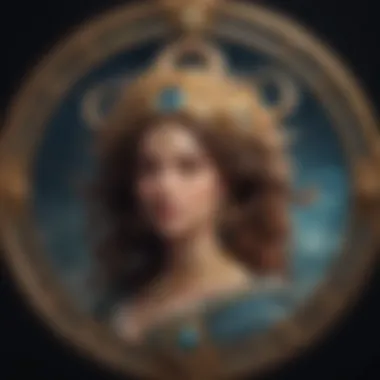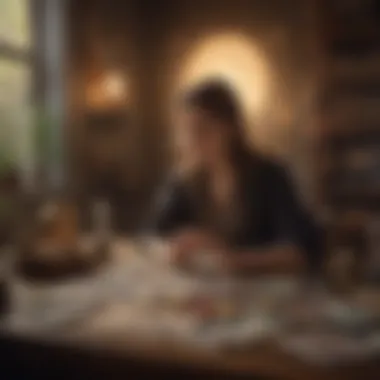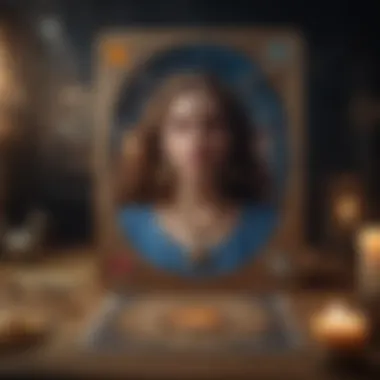Exploring the Intersection of Horoscope and Tarot Reading


Intro
The combination of horoscopes and tarot reading presents a rich tapestry of insight for those navigating their spiritual journeys. While horoscopes derive their wisdom from the positions of celestial bodies at the time of an individual's birth, tarot reading offers a more immediate and symbolic insight into one's current life circumstances. Together, these practices create a multifaceted approach to self-discovery and guidance.
In this exploration, we will outline key features of both horoscopes and tarot reading. By understanding how these systems complement each other, individuals can gain profound insights into their personal development and spiritual pathways.
Zodiac Sign Overview
General Traits and Characteristics
Each zodiac sign carries distinct traits, which can help individuals understand their own behaviors and motivations. For instance, Aries are often seen as assertive and adventurous, whereas Pisces are typically reflective and empathetic. Recognizing these characteristics can offer valuable self-awareness, leading to better decision-making.
Elemental Associations
Zodiac signs are grouped into four elements: fire, earth, air, and water. Each element embodies specific qualities that influence the signs it comprises. Fire signs resonate with passion and dynamism, whereas earth signs are practical and grounded. Understanding one’s elemental association can enhance individual insight and promote personal growth.
Ruling Planets
Each zodiac sign is also linked to a ruling planet, which further influences its characteristics. For example, Leo is ruled by the sun, symbolizing vitality and confidence, while Taurus is ruled by Venus, representing love and beauty. Knowing the ruling planet can deepen the understanding of how cosmic energies affect personal traits and experiences.
Compatibility Analysis
Relationship Dynamics with Other Zodiac Signs
Understanding compatibility between different zodiac signs can illuminate the dynamics of personal and professional relationships. For example, the fiery nature of Sagittarius may clash with the more subdued personality of Capricorn. These dynamics can indicate potential challenges and strengths in relationships.
Friendship Compatibility
Friendship alignments are equally important. Signs within the same element often relate easily. For instance, air signs like Gemini, Libra, and Aquarius share a social and intellectual connection that fosters friendship. Recognizing these patterns can lead to stronger, more fulfilling connections.
Family and Workplace Relationships
Compatibility extends into family and workplace relationships as well. Knowing the zodiac profiles of colleagues can improve teamwork and productivity. Understanding familial dynamics can pave the way for harmony and conflict resolution.
Astrological Influences
How Current Celestial Events Affect Each Sign
Celestial events, such as eclipses and retrogrades, have significant influences on each zodiac sign. For instance, a full moon in Cancer may heighten emotional sensitivity for Cancer individuals, prompting reflection and growth. Awareness of these influences can help individuals prepare for and navigate challenges.
Monthly and Weekly Influences
Astrology is not only about long-term traits but also immediate effects. Monthly and weekly horoscopes can provide timely guidance, offering insights suited for current circumstances. Readers can align their actions according to these cycles for improved outcomes.
Personal Growth Opportunities Through Astrology
Astrology can serve as a catalyst for personal growth. By analyzing horoscopes and reflecting on tarot readings, individuals can uncover paths for self-discovery and development. The integration of astrology and tarot reading allows for a more holistic approach to understanding life’s complexities.
This intersection of horoscopes and tarot empowers individuals to navigate their unique spiritual journeys effectively.
Through this comprehensive exploration, we will delve deeper into how horoscopes and tarot complement and enrich each other, guiding readers towards deeper personal insights and spiritual clarity.
Prelude to Horoscope and Tarot Reading
The exploration of horoscope and tarot reading is vital for those interested in astrology and divination. This article delves into these practices, aiming to reveal their complexities and nuances. Understanding how horoscopes and tarot readings intersect can be beneficial for personal growth and self-discovery. It helps individuals connect the dots between their astrological influences and personal guidance offered through tarot.


Horoscopes provide insights based on the positions of celestial bodies at the time of one's birth. They can reveal traits, challenges, and themes in a person's life. On the other hand, tarot reading offers a different approach. It utilizes a set of cards to guide individuals in decision-making and self-reflection. Both practices, while distinct, complement each other, creating a more comprehensive spiritual framework.
Some key elements include:
- Insight Generation: Both systems offer valuable insights. Horoscopes can inform a person’s current phase, while tarot can provide deeper perspectives on immediate challenges.
- Spiritual Growth: Engaging with these tools fosters a deeper understanding of oneself, promoting personal development.
- Integration of Practices: This intersection allows individuals to blend astrological data with tarot insights, enriching their spiritual experience.
Understanding these elements is crucial for those looking to enhance their self-awareness through alternative practices. The significance of combining horoscopes and tarot cannot be understated; it holds potential for profound personal exploration.
Understanding Horoscope
Horoscopes are a part of astrology that analyzes the positions and movements of celestial bodies to derive insights about a person’s life. The primary element of a horoscope is the natal chart, which maps the positions of the sun, moon, and planets at the moment of one’s birth. Each position in the chart can influence personality traits, behaviors, and life events. Horoscopes generally categorize individuals based on their zodiac signs, which are determined by the sun’s position at birth.
One crucial aspect of horoscopes is the notion of the twelve astrological signs. Each sign represents unique characteristics and challenges. For instance, Aries is often associated with leadership and ambition, while Taurus is known for stability and a love for comfort. Understanding these characteristics can provide personal insights that guide choices and behavior.
Astrologers also consider the houses in a horoscope. Each house represents different areas of life, such as relationships, career, and personal identity. The planets' placements in these houses add layers to the interpretation, helping individuals understand where energies are focused in their lives. Additionally, transits and progressions offer dynamic views, indicating how ongoing cosmic events influence a person's natal chart.
Understanding Tarot
Tarot reading is an ancient practice that uses a deck of cards to gain insights into one’s life and circumstances. A standard tarot deck consists of 78 cards, divided into the Major and Minor Arcana. The Major Arcana cards symbolize significant life events and lessons, while the Minor Arcana focuses on day-to-day experiences.
Each card carries its own symbolism and meaning. When interpreting cards, readers often look for patterns and combinations that arise during a reading. For example, drawing The Fool may indicate new beginnings, while The Tower could suggest a sudden disruption. This rich tapestry of symbols allows individuals to reflect on their lives and consider different perspectives on their issues.
Tarot readings can take many forms, including the popular three-card spread or more elaborate layouts like the Celtic Cross. Depending on the question and context, different spreads may highlight specific influences or aspects of one’s life. Traditional interpretations combine with intuitive insights, making each reading unique.
Historical Context of Horoscope and Tarot
Understanding the historical context of horoscope and tarot is essential to appreciate their significance today. Both practices emerged from rich traditions and philosophies, deeply intertwined with human culture. Situating these systems in their historical frameworks provides insights into their development and adaptation over time.
The Origins of Horoscope
The roots of horoscope date back to ancient civilizations, notably the Babylonians around the second millennium BCE. They observed celestial bodies like the sun, moon, and stars, developing one of the earliest astrological systems. They noted the correlation between celestial events and earthly occurrences. This groundwork laid the foundation for horoscopic astrology as we know it today.
Horoscopes are fundamentally based on the positioning of planets at the time of a person's birth. The zodiac, divided into twelve signs, became an essential aspect of this practice. Each sign corresponds to specific personality traits, influencing individual characteristics and destinies.
The Greek philosopher Ptolemy later contributed significantly to astrology in the second century CE. His work,
Methodologies of Horoscope Reading
Understanding the methodologies behind horoscope reading is crucial for several reasons. First, these methodologies provide a structured approach to interpreting celestial influences. They allow astrologers to derive meaningful insights from complex astrological data. Moreover, they reflect the dynamic nature of astrology, emphasizing that personal and cosmic energies are interconnected and influential.
The specific elements within these methodologies—such as astrological signs, houses, and planetary transits—are used to construct an astrological chart. This chart serves as a foundational tool in horoscope reading, guiding practitioners in their analysis. By leveraging these methodologies, individuals can enhance their self-awareness and understanding of their life paths.
It's essential to consider the benefits of mastering these methodologies as well. For example, they offer clarity in decision-making. Equipped with this knowledge, readers are better positioned to navigate both challenges and opportunities.
Astrological Signs and Their Meaning
Astrological signs are arguably the most recognizable component of astrology. Each sign, spanning from Aries to Pisces, carries its own set of characteristics, strengths, and weaknesses. An astrologer looks at not only the sun sign but can also evaluate the moon and rising signs for a more nuanced understanding of an individual’s personality.
For example, an Aries might be perceived as impulsive and energetic, while a Taurus may be more reliable and grounded. Understanding these attributes can significantly inform personal interactions and self-reflection. Recognizing one's sign is the first step in harnessing its potential for intuition and guidance.
Houses and Their Influence
Each astrological chart is divided into twelve houses, each representing different life areas. These houses correlate with various aspects like relationships, career, and personal growth.
- First House: Represents self-image and beginnings.
- Second House: Tied to personal finances and possessions.
- Third House: Governs communication and local travel.
The position of planets within these houses further informs how energies manifest in one�’s life. For instance, if Venus occupies the Fifth House, love and creativity may flourish, suggesting a truly enriching time for personal expression. The understanding of these houses allows individuals to pinpoint where to focus their energies based on their current life situations.


Transits and Progressions
Transits and progressions are two critical components that astrologers consider during horoscope readings. These methods examine how the movements of celestial bodies affect an individual’s natal chart over time.
- Transits: This involves analyzing the current positions of planets and how they influence natal placements. For example, a Jupiter transit through natal Sun can lead to expansion and optimism in various life areas.
- Progressions: In this method, planets are progressed forward in time, often reflecting internal growth. It shows personal development and evolving circumstances.
Both approaches help readers understand cycles of life, enabling them to anticipate shifts and embrace opportunities as they arise. better navigating through life's complexities requires an awareness of these dynamics.
"Astrology is not a science to predict the future but rather a tool to comprehend oneself and one’s circumstances."
Methodologies of Tarot Reading
Understanding the methodologies behind tarot reading is crucial in gaining a comprehensive insight into its practices and benefits. Tarot reading is more than just a simple fortune-telling method; it encompasses complex tools and techniques that can aid individuals in self-reflection and personal growth. Each methodology contributes to the depth and richness of the readings. Common practices include card selection, interpretation techniques, and creating meaningful spreads. These methodologies not only enhance a reader's skill set but also deepen the connection between the reader and the querent.
Understanding Tarot Cards
Tarot cards form the foundation of this divinatory practice. Each card possesses distinct imagery, symbols, and meanings, which together weave a narrative that reflects the querent's life circumstances and questions. A standard tarot deck consists of 78 cards divided into the Major Arcana and the Minor Arcana. The Major Arcana cards, such as The Fool and The World, represent significant life events and spiritual lessons. In contrast, the Minor Arcana cards reflect day-to-day experiences and challenges.
Understanding tarot cards requires an awareness of both their symbolic value and intuitive insights. Readers often spend time studying the card meanings to internalize their messages. Establishing a personal connection with each card helps in developing a unique reading style that resonates at a deeper level, allowing for a richer interpretation during sessions.
Common Tarot Spreads
The arrangement of tarot cards in a spread plays a significant role in shaping the reading's insights. Various spreads serve different purposes, depending on the complexity of the questions being addressed. Some common spreads include:
- Three-Card Spread: This is a straightforward approach that usually involves past, present, and future positions to offer insight into a situation.
- Celtic Cross Spread: This more elaborate spread provides a detailed analysis of various aspects of a querent's life, including challenges and opportunities.
- Relationship Spread: This spread focuses on interpersonal dynamics, shedding light on the complexities of relationships.
Each spread has its own methodology in terms of the order of the cards, positional meanings, and overall intent. Familiarity with these common configurations allows tarot readers to select the most suitable spread for the querent's question.
Interpreting Card Meanings
Interpreting card meanings is a fundamental skill in tarot reading that combines knowledge and intuition. The process involves understanding the symbology and numerology associated with each card while also tuning into the energies present during the reading.
While book definitions provide a baseline for card meanings, it's important for readers to allow their intuition to guide them. Developing the ability to connect personal insights with universal meanings can create a richer narrative in readings. Readers may also combine elements from various interpretations to formulate a holistic perspective specific to the querent's inquiry.
The true essence of tarot lies in its capacity to empower self-discovery and personal growth. Each reading offers a mirror, allowing individuals to reflect upon their path and choices.
By mastering these methodologies, tarot readers can provide valuable guidance that goes beyond mere predictions. This structured yet flexible approach enriches the experience for both the reader and the querent, ultimately fostering a deeper understanding of life's complexities.
The Synergy Between Horoscope and Tarot
The connection between horoscope and tarot reading creates a rich tapestry of insights for individuals seeking deeper understanding in their lives. Both practices serve as windows into the self and the universe, providing unique perspectives that, when combined, can enhance personal growth and decision-making.
Complementary Practices
Horoscope and tarot can be seen as complementary practices rather than separate entities. Astrology, through the horoscope, offers a broad view of an individual’s traits based on planetary positions. It informs the seeker about inherent strengths and challenges. For example, a person with a strong Scorpio influence might face emotional depth and intensity. This understanding is valuable, as it helps in recognizing the motivations behind one’s actions.
Tarot, on the other hand, provides specific guidance for immediate situations. Each card in the tarot deck has symbolic meanings that can change based on the question and spread used. For instance, the appearance of The Tower card often indicates sudden shifts or unexpected challenges, which can illuminate issues that horoscopes may not explicitly address.
Integrating these practices allows users to cross-reference insights. For example, if the horoscope suggests a time for renewal and change, pulling tarot cards can help clarify what changes to focus on in daily life. By using these two methods together, a more nuanced understanding of personal circumstances can emerge.
Integrating Insights for Self-Discovery
The integration of horoscope and tarot can be a powerful tool for self-discovery. Each system sheds light on different aspects of existence. Horoscopes can signify the cyclical flow of cosmic energies, while tarot can offer immediate clarity and guidance based on current life situations. Together, they can create a roadmap for introspection and growth.
To effectively integrate insights from both practices, individuals can consider the following steps:


- Use Horoscope Insights as a Framework: Begin with a horoscope reading. Understand the key themes for the period.
- Draw Tarot for Clarity: Following the horoscope reading, pull a tarot spread that relates to those themes.
- Reflect on Connections: Take time to reflect on how the tarot cards interact with astrological insights.
For instance, if a horoscope indicates a period of introspection, tarot cards like The Hermit can signify deep internal work and highlight specific areas for development. These reflections can encourage individuals to take actionable steps towards awareness and personal growth.
Integrating both practices provides a comprehensive approach to understanding oneself and the world.
By exploring the synergy between horoscope and tarot, individuals can engage in a more profound spiritual journey. This combination fosters a greater connection with both the self and the cosmos, illuminating pathways toward personal empowerment.
Practical Applications in Daily Life
Understanding how to incorporate horoscopes and tarot reading into everyday life offers valuable tools for self-awareness and decision-making. By applying these ancient practices to modern scenarios, individuals can deepen their insights and enhance their daily experiences. This section outlines significant ways in which horoscopes and tarot can influence day-to-day choices, guiding practitioners toward a more fulfilling life.
Using Horoscopes for Decision Making
Horoscopes can serve as an influential guide in navigating life’s choices. They provide insights based on astrological alignments and cosmic events. This can be particularly beneficial during times of uncertainty or when faced with tough decisions.
- Personal Insights: Horoscopes often delineate personality traits associated with one's zodiac sign. Understanding these traits can help individuals recognize their strengths and weaknesses, informing decisions that align with their true nature.
- Timing and Cosmic Conditions: Astrological events like Mercury retrograde or lunar phases impact decision-making. Consulting a horoscope can reveal favorable periods for launching projects or making significant changes.
- Emotional Clarity: Understanding the emotional landscape foreseen in horoscopes can prevent impulsive decisions. It can foster a reflective approach, guiding choices that resonate more with one’s core values.
Incorporating horoscopes into everyday decision-making can create a more mindful approach to life. Keeping tabs on personal horoscopes allows individuals to anticipate challenges and embrace opportunities with greater awareness.
Harnessing Tarot for Guidance
Tarot reading provides another layer of insight that complements the astrological perspective. The symbolism and imagery within tarot cards can yield profound guidance, uncovering deeper truths that horoscopes may not encapsulate.
- Access to Intuition: Tarot encourages users to tap into their intuition. The act of drawing cards often reveals subconscious thoughts, assisting individuals in making informed choices.
- Situational Analysis: Each tarot card conveys specific meanings, enabling a nuanced analysis of a current situation. By interpreting the cards, one can gain clarity on complex matters, from career shifts to personal relationships.
- Task Orientated Focus: Specific spreads, such as the Celtic Cross or Three-Card Spread, can target particular concerns or questions. These spreads provide structured insights, helping practitioners focus on the most pressing aspects of their lives.
By regularly engaging with tarot cards, individuals can maintain a consistent source of guidance. This practice is especially potent when used in conjunction with horoscope readings, fostering a holistic view of personal development and decision-making.
“Integrating horoscopes and tarot into daily life is not merely about predictions; it's about fostering a greater sense of self and enhancing one's decision-making capabilities.”
Challenges and Considerations
The examination of challenges and considerations regarding horoscope and tarot reading is essential for appreciating their complexities. This topic highlights various facets that practitioners and seekers must contemplate. Understanding these challenges contributes to a more profound and respectful engagement with both practices.
Skepticism and Criticism
Skepticism surrounding horoscope and tarot readings is prevalent. Many criticize these practices as unscientific, leading to questions about their validity. Critics argue that horoscopes lack empirical evidence, viewing them as mere entertainment rather than genuine guidance. The uncertainty around tarot reading often stems from its subjective interpretation, which can vary widely from reader to reader.
However, skepticism can be beneficial. It encourages individuals to approach these practices with a discerning mind. It can foster deeper exploration of their personal beliefs. The challenge lies in balancing skepticism with openness. Acknowledging potential limitations while embracing insights can lead to a more enriched experience.
Nonetheless, it is crucial to differentiate skepticism from outright dismissal. Constructive criticism encourages practitioners to refine their approaches and uphold ethical standards. By addressing concerns with transparency, practitioners can establish credibility while remaining accessible to those seeking guidance.
Ethical Implications of Readings
The ethical implications surrounding both horoscope and tarot readings warrant significant attention. Practitioners hold a vital role in shaping clients' experiences. They need to embrace a sense of responsibility for the guidance they provide. Misrepresentation of abilities or offering overly deterministic forecasts can cause harm. A blurred line between entertainment and genuine support may lead individuals to make decisions based on superfluous insights.
Practitioners should prioritize informed consent. Clear communication about the nature of the reading is essential. Clients must understand that readings are interpretations rather than definitive forecasts. Moreover, maintaining confidentiality protects clients' personal information, fostering trust in the practitioner-client relationship.
Responsible practitioners should remain aware of their limitations. They must refrain from offering advice on critical issues such as legal matters, financial decisions, or medical concerns. Similarly, reading one's chart may lead to bias; thus, self-awareness is fundamental.
In summary, both skepticism and ethical considerations are critical in exploring the interplay between horoscope and tarot reading. They ensure that engagement with these practices remains thoughtful and respectful, ultimately enhancing the individual experience.
The End
In this article, we explored the intricate relationship between horoscope and tarot reading. Both practices hold significant value in the fields of astrology and divination, serving as tools for personal insight and guidance. Understanding their individual methodologies and historical context allows practitioners to appreciate their synergy better.
The key elements discussed highlight the importance of integrating insights from both systems for self-discovery. For instance, while horoscopes provide a framework for understanding astrological influences based on birth charts, tarot offers a dynamic approach through card interpretation. Together, they can enhance the clarity of one’s personal journey.
Benefits of engaging with both practices include a deeper understanding of oneself and the challenges one faces. Those seeking guidance often find that horoscopes inform their daily decisions, while tarot can illuminate specific issues or dilemmas.
However, it is crucial to approach these tools with an open mind yet a critical perspective. Skepticism about their effectiveness is common, and ethical considerations regarding their use must be addressed seriously. Being mindful of these aspects contributes to a responsible and enriching practice.
Engaging with horoscopes and tarot can enrich one's spiritual life, providing layers of insights that can lead to meaningful transformations. As we conclude, it’s clear that the intersection of these two practices not only offers guidance but also invites individuals to embark on a deeper journey of self-exploration and understanding.



